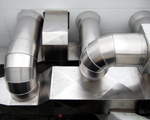It is common belief that a series of elbows near an air handling unit (AHU) can accomplish the same insertion loss as a manufactured duct sound attenuator. It’s true that elbows are less expensive than sound attenuators, but what acoustical performance is really achieved with this “low cost” substitution?
Let’s compare the two designs. Using the tables presented in the 2007 ASHRAE Handbook – HVAC Applications, for any type of elbow (round, rectangular, acoustically lined or not), the width of an elbow (in the plane that it turns) must equal or exceed 30 inches to get ANY insertion loss at 63 Hz. A 30 inch wide elbow provides only 1 dB of insertion loss (IL) at 125 Hz . These two frequencies are typically of concern when reducing sound from AHUs.
At 63 Hz, an elbow must be at least 60 inches wide to break into the IL domain of sound attenuators at 4 dB. This width dimension is a minimum of 30 inches for 125 Hz. Ultimately, the cap on elbow IL tops out as follows in the table. To obtain this amount of IL at 125 Hz, an elbow must be at least 60 inches wide.
| Lined square elbow with turning vanes (duct must be lined before and after the elbow) |
7 dB |
| Unlined square elbow with turning vanes |
6 dB |
| Lined square elbow without turning vanes |
11 dB |
| Unlined square elbow without turning vanes |
8 dB |
| Lined round elbows |
not provided |
| Unlined round elbows |
3 dB |
Sound attenuators typically have roughly 4 to 10 dB of IL at 63 Hz and 8 to 20 dB at 125 Hz. Some designs provide substantially higher IL than this.
It can quickly be seen that for smaller elbows, say 30 inches and under, IL equivalence between elbows and sound attenuators is difficult or impossible to achieve. At the larger duct sizes, the system would have to be carefully designed to obtain equivalent low frequency IL.
What about higher frequencies? Sound attenuators typically provide 20-40 dB of IL in the mid frequency bands and 10-15 at the highest tested frequencies. If this is where you need IL (vane axial and mixed flow fans come to mind), a sound attenuator is far superior to a series of elbows.
Furthermore, to avoid aerodynamically induced noise, the airflow velocity must be slow enough and the elbows must be spaced far enough apart. Extra sheet metal is needed in both cases, driving up the cost of the “cheap” elbow configuration. Additionally, the attenuator will accomplish the required IL in a much shorter distance…an attractive proposition for HVAC systems tight on space or that enter acoustically sensitive areas quickly. Duct lagging, heavy gauge sheet metal and long lengths of duct lining might help, but all have their cost implications.
That “expensive” sound attenuator might not look so costly after all.

Great Article.
On a separate note, It has always been preached and taught that first you need to analyze a duct system using single wall duct components taking into account all the natural attenuation of said components (i.e., power splits, elbow attenuation, duct attenuation, end reflection and room acoustics). Then and only then, if required should you introduce any additional attenuation, whether it be insulated duct, duct elbows, or duct silencers.
Yes, when using single-wall or double-wall elbow duct components or elbow silencers, close coupling of elbows with respect to themselves, prime mover (fan) and other duct components is an important considersation. System effect pressure losses (in. WG) are often unaccounted for and can be considerably higher than what some might expect resulting in costly suprises at time of system startup. The use of single thickness turning vanes is very important when using mitered rectangular elbow duct fittings but system effect still needs to be taken into account. Elbow silencers have curve baffles along the air passage so they don’t need additional turning vanes but system efffect pressure loss still needs to be taken into account and added to the silencer or duct elbow pressure loss.
A final separate comment, breakout noise of elbows is of concern as well when acoustically designing duct systems. Sometimes you want noise to break out of the elbow as a form of sound attenuation along the duct run, but many times you want to control the breakout noise. There is a misconception that 10 gage solid outer casing for elbow silencers are required to control this breakout noise. But in a majority of cases using such a heavy gage only provides the owner with silencers that are extremely heavy which introduce increased initial costs and installation costs. Comparing the transmission loss offered by 16 gage verses 10 gage solid outer skins, you find that 10 gage only offers minimal TL points better than 16 gage solid outer skins and 16 gage costs the owner considerably less than 10 gage both in initial and installation costs.
Just a few thoughts.
Best Regards,
Sofra
John, Thank you for your thoughts. I joke with the mechanical engineers that I prefer paper ducts in the mechanical room to allow the most energy to be dumped in a place where it doesn’t matter. The need for and placement of duct lagging or heavy gauge metal is indeed another part of the design. Do you have data or a reference on 16 ga vs. 10 ga transmission loss for specific duct sizes? My reference says the transmission loss difference is 3-4 dB pretty much across the spectrum, but I believe that’s ASTM E-90 flat panel data. -Mandy
Appreciate you sharing, great blog post.Really thank you! Will read on…